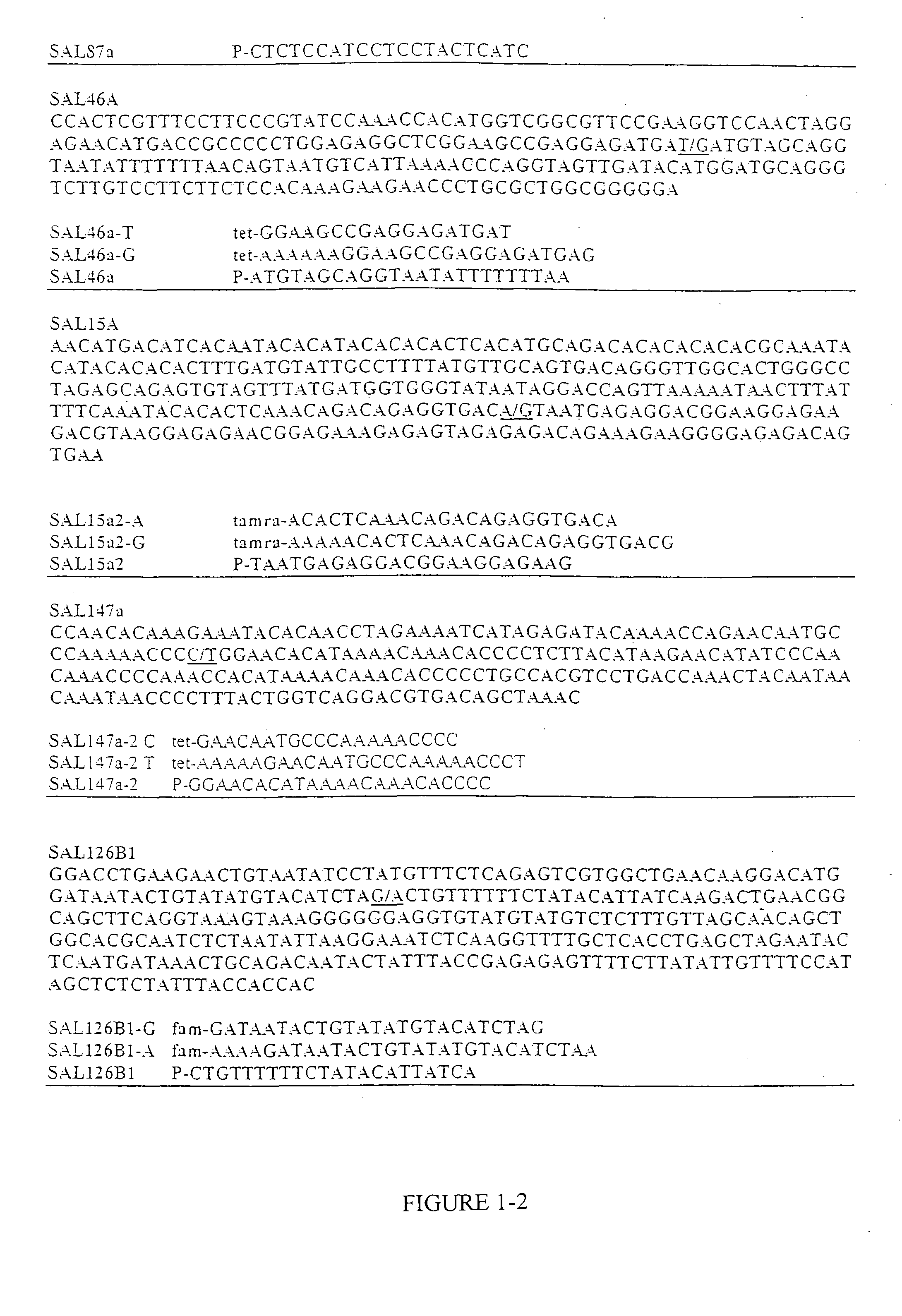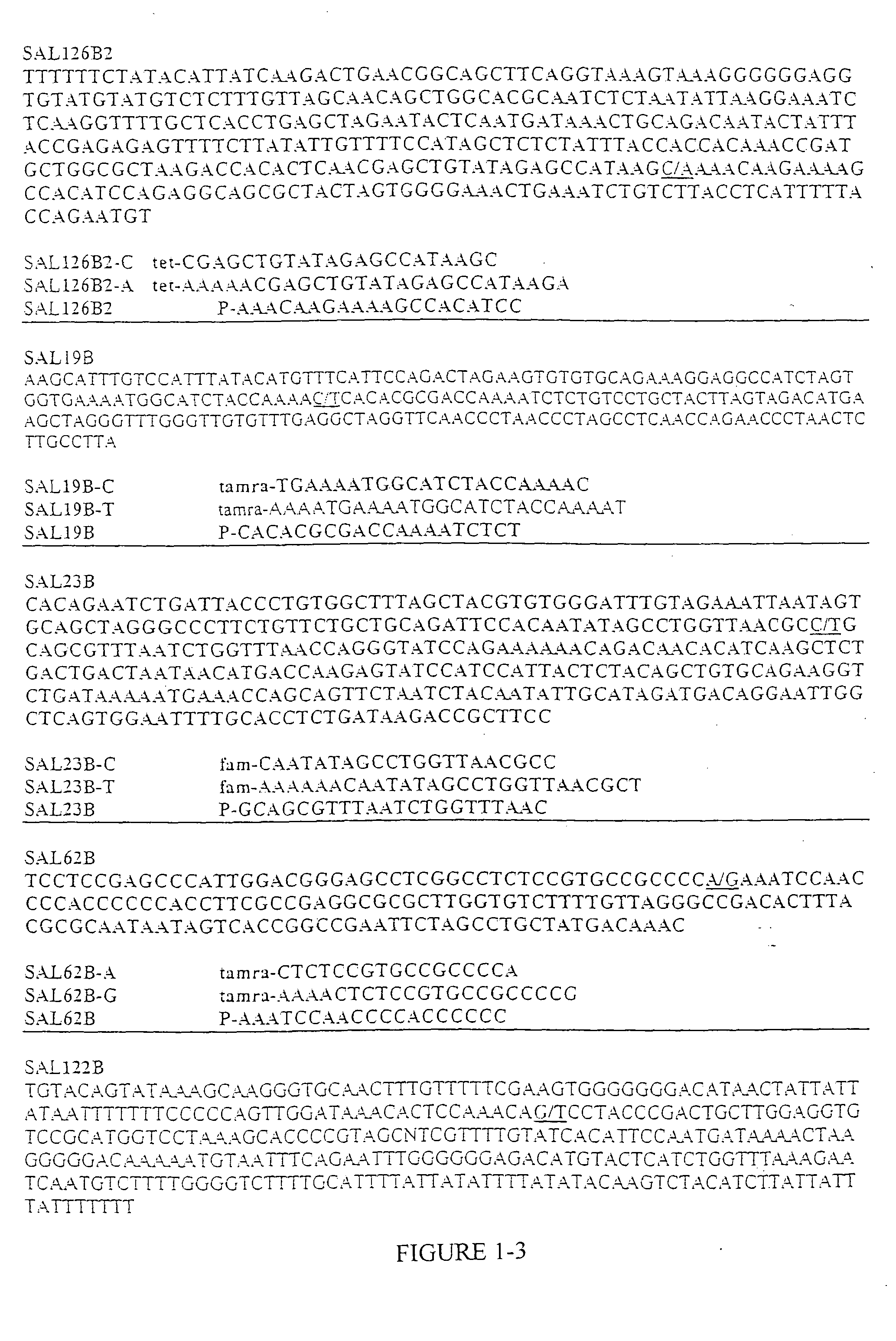Verification of food origin based on nucleic acid pattern recognition
a nucleic acid pattern and food origin technology, applied in the field of applying genomics methods, can solve the problems of unreliable existing traceability systems and no available system for seafood retail traders and consumers
- Summary
- Abstract
- Description
- Claims
- Application Information
AI Technical Summary
Problems solved by technology
Method used
Image
Examples
example i
Isolation of SNP Markers from Salmon and Tilapia
[0097] This example describes isolation of genomic DNA containing SNP markers from an Atlantic salmon (Salmo salar) individual and a Nile tilapia (Oreochromis niloticus) individual.
[0098] Two genomic libraries, one for tilapia and one for salmon were constructed using the following procedure. The genomic DNA was digested with restriction enzyme Sau 3A (Gibco BRL) followed by electrophoresis in a 1% TBE agarose gel. Using 1 Kb DNA size ladder (Amersham Pharmacia), DNA fragments of the size range 900-1100 bp were excised from the gel and isolated using QIAquick Gel extraction kit (Qiagen). The isolated DNA fragments were then ligated to Ready-to-Go pUC18 (Amersham Pharmacia), linearized with BamHI, BAP treated and formulated with T4 DNA ligase, followed by transformation into E. coli Pack Gold supercompetent cells (Stratagene). Cells from the libraries were grown on LA amp agar plates and clones were picked at random and cultured over ...
example 2
Determination of SNP Variation in Tilapia and Salmon
[0103] This example describes the analysis of tilapia and salmon SNPs by oligonucleotide ligation assay (OLA). The three primers of a OLA analysis were designed as follows: [0104] 1) Allele-specific oligonucleotide-1: 5′ABI_colour-(PRIMER SEQUENCE)-X-3′[0105] 2) Allele-specific oligonucleotide-2: 5′ABI_colour-AAAAA-(PRIMER SEQUENCE)-Y-3′[0106] 3) Joining-oligonucleotide: 5′-P-PRIMER-3′
[0107] The allele discriminating primer were selected from the upstream flanking sequence of the SNP, including the SNP point, and end labeled with a fluorescent dye compatible with the ABI 377 Automated Sequencer machine (tamra, fam or tet). Both allele specific oligonucleotide 1 (AS1) and AS2 were labeled with the same dye. The X and Y at the 3′ end of AS1 and AS2, respectively, indicate the nucleotide discriminating the SNP. The AS2 oligonucleotide has a five adenine nucleotide extension in order to allow discrimination of the OLA products and, th...
example 3
Isolation of Microsatellite Markers from Atlantic Salmon, Tilapia, Cod, Atlantic Halibut, Seabass
[0110] This example describes isolation of genomic DNA containing microsatellite markers from an Atlantic salmon individual, a Nile tilapia individual, a Cod individual, an Atlantic halibut individual, a Seabass individual.
[0111] The procedure for isolation of microsatellite containing DNA was identical for each species. The procedure set forth below describes the isolation from one species.
[0112] A genomic library was constructed using the following procedure. Genomic DNA was digested with restriction enzyme Sau 3A (Gibco BRL) followed by electrophoresis in a 1% TBE agarose gel. Using 1 Kb DNA size ladder (Amersham Pharmacia), DNA fragments of the size range 900-1100 bp were excised from the gel and isolated using QIAquick Gel extraction kit (Qiagen). The isolated DNA fragments were then ligated to Ready-to-Go pUC18 (Amersham Pharmacia), linearized with BamHI, BAP treated and formula...
PUM
| Property | Measurement | Unit |
|---|---|---|
| length | aaaaa | aaaaa |
| volume | aaaaa | aaaaa |
| volume | aaaaa | aaaaa |
Abstract
Description
Claims
Application Information
 Login to View More
Login to View More - R&D
- Intellectual Property
- Life Sciences
- Materials
- Tech Scout
- Unparalleled Data Quality
- Higher Quality Content
- 60% Fewer Hallucinations
Browse by: Latest US Patents, China's latest patents, Technical Efficacy Thesaurus, Application Domain, Technology Topic, Popular Technical Reports.
© 2025 PatSnap. All rights reserved.Legal|Privacy policy|Modern Slavery Act Transparency Statement|Sitemap|About US| Contact US: help@patsnap.com



